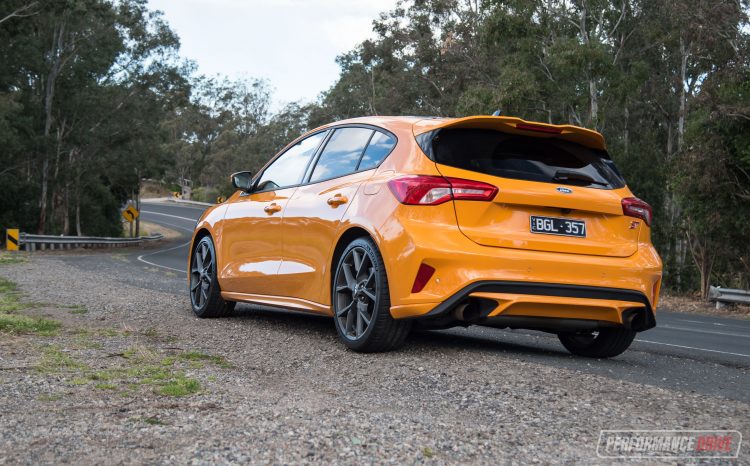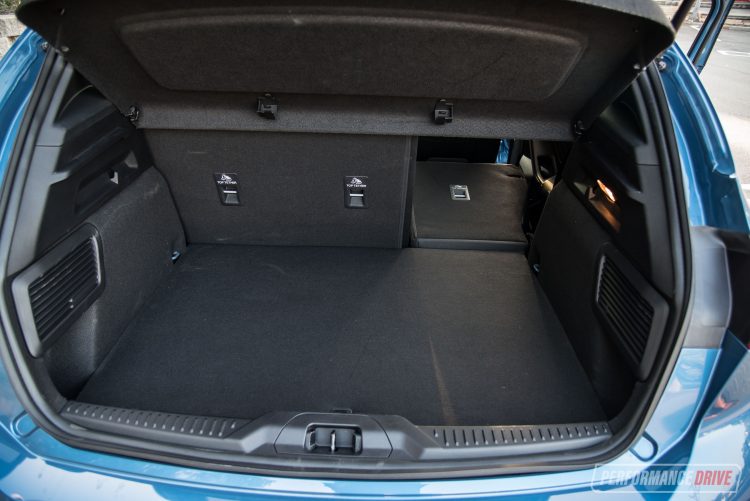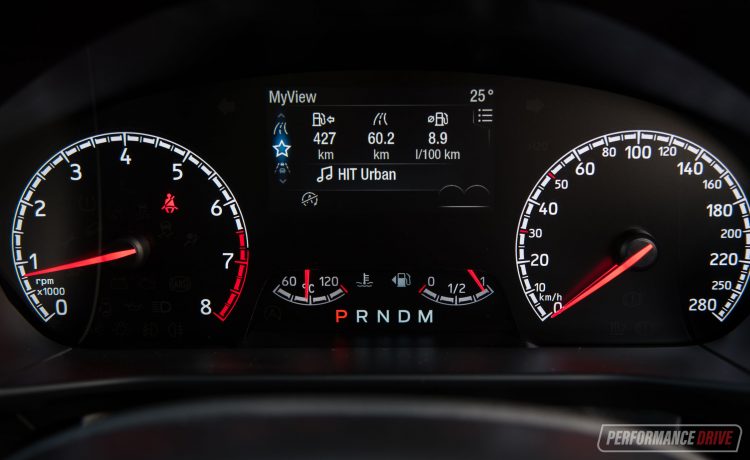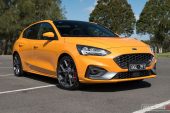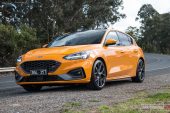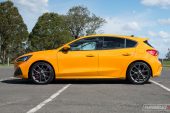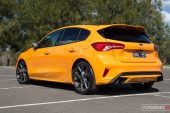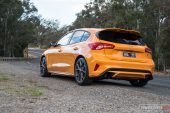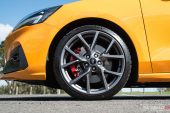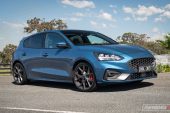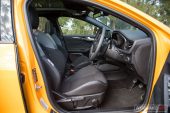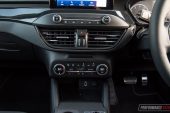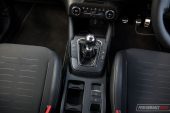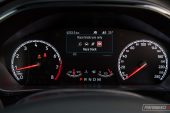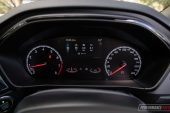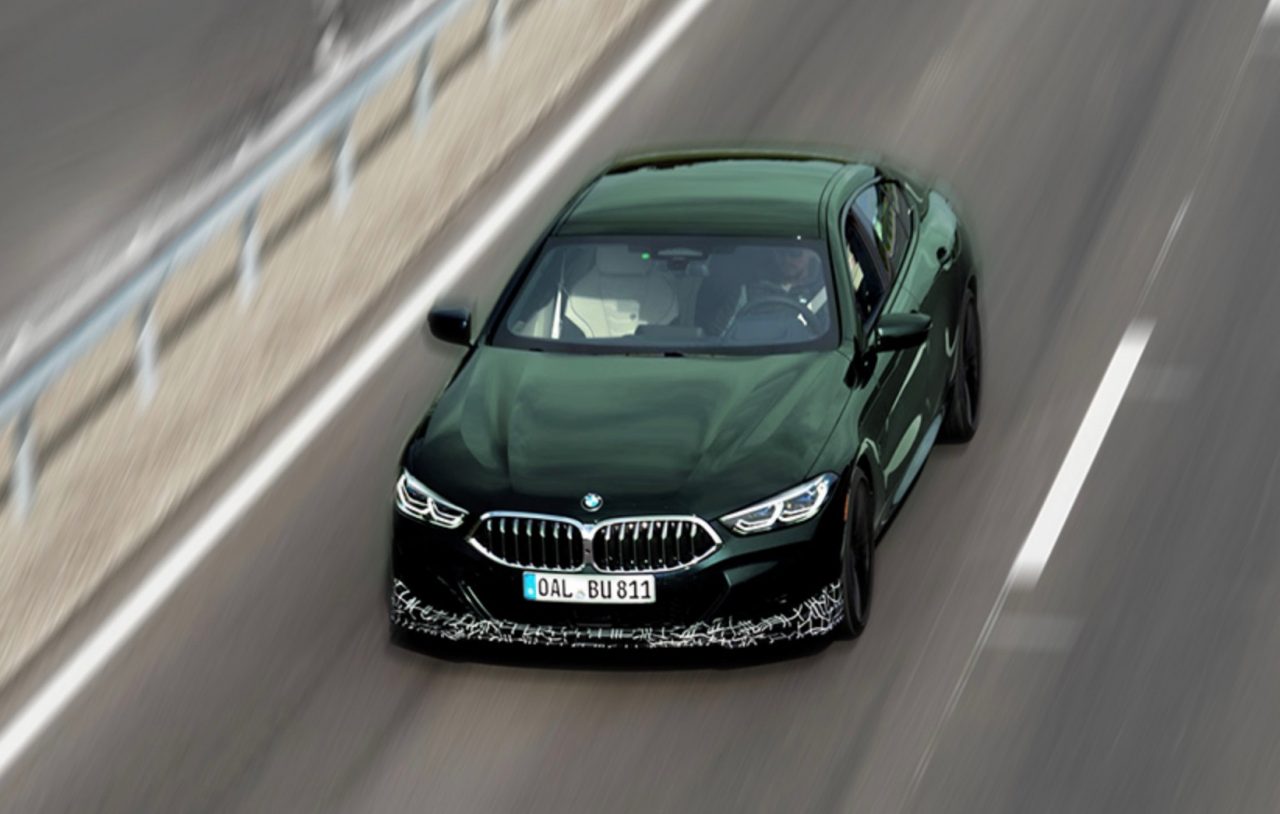The hot hatch world is sizzling fiercely at the moment and is almost ready to burst through the pressure cooker. That’s great for driving fans because it means there are lots of options to choose from. However, when it comes to versatility the new 2020 Ford Focus ST is one of the most attractive, purely because it is available in both manual and auto forms.
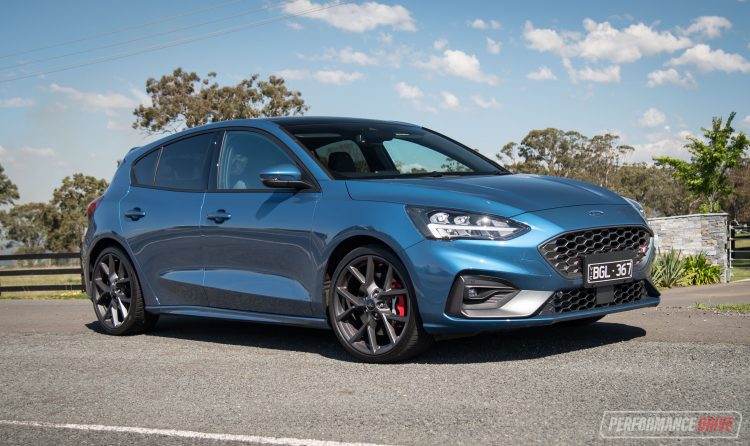
Why is that such a big deal? Ordinarily, it mightn’t be a big deal but for some reason hot hatch producers are cutting off a big chunk of the market simply because they only build manual models. The Honda Civic Type R, Hyundai i30 N (auto coming soon), and even the Renault Megane RS Cup up until recently are manual-only.
We get it, manuals are definitely more engaging and the purer form of driving. But the market trend is overwhelmingly inclined to auto. Having the option, at least, is a great move. And Ford has done even better by offering the latest Focus ST from $44,690, for the manual or auto. There is no price difference. Here we’re giving both transmissions a crack to see how they go.
Brett Davis contributed to this review
2020 Ford Focus ST manual | auto – THE SPECS
[column width=”47%” padding=”6%”]Engine: 2.3-litre turbo four-cylinder
Output: 206kW@5500rpm / 420Nm@3000-4000rpm
Transmission: Six-speed manual | seven-speed auto
Drive type: Front-wheel drive, limited-slip differential
Wheels: F: 19×8.0, 235/35
ANCAP: Not tested (regular Focus 5 stars)
Tare weight: 1506kg | 1532kg
Power-to-weight: 7.31:1 | 7.44:1 (kg:kW)
Official fuel economy: 8.1L/100km | 8.6L/100km
Economy during test: 8.1L/100km | 8.9L/100km[/column] [column width=”47%” padding=”0″]Fuel capacity/Type: 52L/95 RON
Power efficiency: 25.43kW:L/100km | 23.95kW:L/100km
0-60km/h: 3.29 | 3.00 seconds*
0-100km/h: 6.30 | 5.72 seconds*
60-110km/h: 3.85 | 3.63 seconds*
1/4 mile: 14.34@165.4 | 14.22@160.0 km/h*
Max acceleration: 0.690g | 0.720g *
100-0km/h braking: 2.85 seconds at 35.42 metres*
Max deceleration: -1.362g
Decibel at idle (/Track mode): 50/54*
Peak decibel at 60-100km/h: 89 | 87*
Priced from: $44,690[/column][end_columns]
* Figures as tested by PerformanceDrive on the day. Factory claims may be different
2020 Ford Focus ST – THE PACKAGE
Being the top-spec Focus, the ST is generous with tech and safety equipment. However, all Focus models come standard with loads of kit these days, including climate control, autonomous emergency braking and all of that, road sign recognition, and a comprehensive touch-screen media interface running Ford’s SYNC 3 software that supports Android Auto and Apple CarPlay.
The extra $19k for the ST over the base model brings in all of the hot hatch temptations, such as adaptive dampers, a sporty aero kit, 19-inch alloy wheels hiding performance red-painted brakes (330mm front and 302mm rear discs), and a sports exhaust. There’s also a 2.3-litre turbo engine under the bonnet that generates 206kW and 420Nm. That level of power is right up there with the hottest of hot hatches, while 420Nm puts it among the front runners.
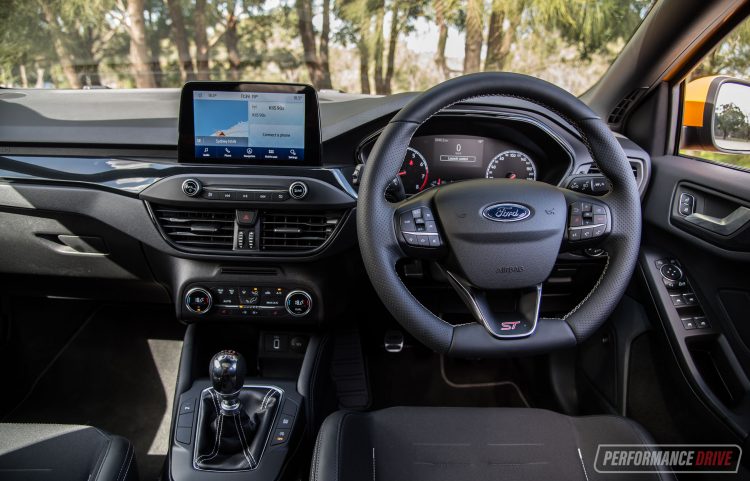
In terms of luxuries and indulgent features though, the ST also adds dual-zone climate control, a thumping 10-speaker B&O sound system, special ambient interior lights, awesome Recaro buckets seats in the front with a unique partial-leather trim, and a wireless phone charger. More advanced safety tech is also shoved in, like rear cross-traffic alert, reverse autonomous emergency braking, and auto high-beam headlights. Overall, we think this is very well priced for the equipment it presents.
Design-wise, the Focus leaps ahead in elegance and sportiness compared to the previous generation Focus. It moves away from random shapes and contours, and towards a more linear and conservative design. And in ST guise, it is nothing short of suggestive of its sporty underpinnings from every angle. The bonnet still aerodynamically swoops its lines towards the rear, and it still carries a hexagonal front grille. The taillights are now more horizontally opposed to give off a wider and more planted appearance. We love the contrasting black highlights, subtle side skirting, and the bright LED lights used all round.
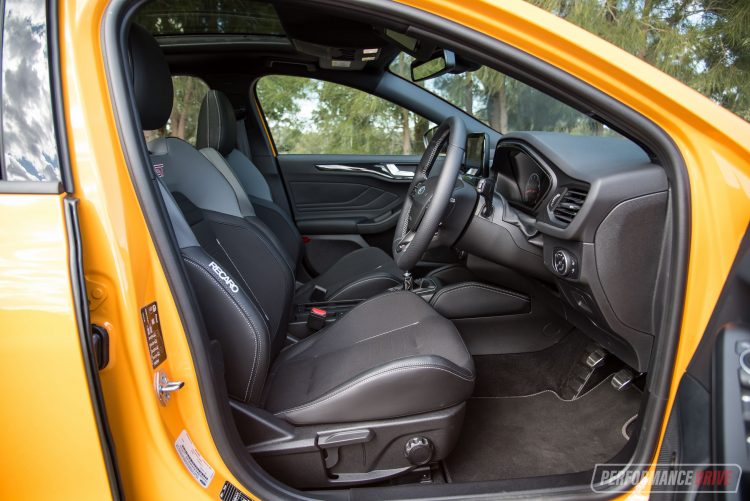
When you sit yourself behind the wheel, you’re held snug into position like a race car driver. These heavily bucketed Recaro seats really stop you rolling around when the road gets windy, but they are also surprisingly comfortable. The dash layout and dials are vastly improved in design and sophistication over the predecessor. Gone are the oddly shaped air vents and dash protrusions.
Now we have a neater, more symmetrical and more practical environment. Especially with the simple button layout, soft blue illumination, aluminium bits, and a flat instrument cluster. Most materials feel high in quality too, with minimal hard plastics to be found. Physical air-conditioning buttons are thankfully still separated out from the 8.0-inch multimedia screen.
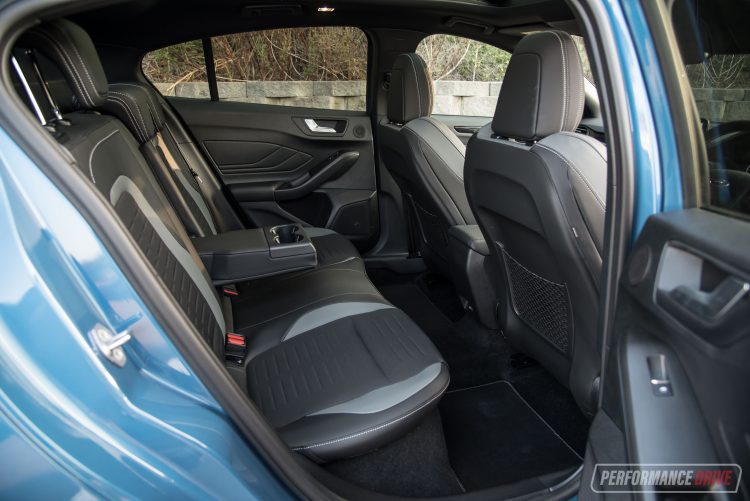
For those that care about how much shopping you can cram into the ST, you’ll be happy to know the boot measures in at a reasonable 375 litres, expanding to 1250L with the rear seats down. Rear seat room is also generous for a hot hatch. You just need to watch your head when hopping in due to a swooping roof line.
All Ford models now come with a generous five-year, unlimited kilometre warranty. Servicing on the ST is required every 12 months or 15,000km; and Ford offers a $299 A and B service guarantee for the first four years or 60,000km.
2020 Ford Focus ST – THE DRIVE
For those who crave an exhilarating drive, you get exactly that with the Focus ST. The ST goes with a rather large 2.3-litre turbo intercooled four-cylinder as mentioned. 206kW is available from a pretty low 5500rpm, and 420Nm is spread across 3000rpm to 4000rpm. During our tests on a private road with a Vbox Sport, we recorded a best 0-100km/h in 6.30 seconds with the manual, and just 5.72 seconds in the auto.
It’s not that the auto feels all that much quicker, it’s that the power delivery is much more linear and traction is less of a concern. From what we could tell, the exhaust system is quieter in the auto, missing out on the loud crackles and pops that are emitted in the manual. Our decibel gauge reflected some difference too, showing a peak recording of 89dB in the manual and 87dB in the auto.
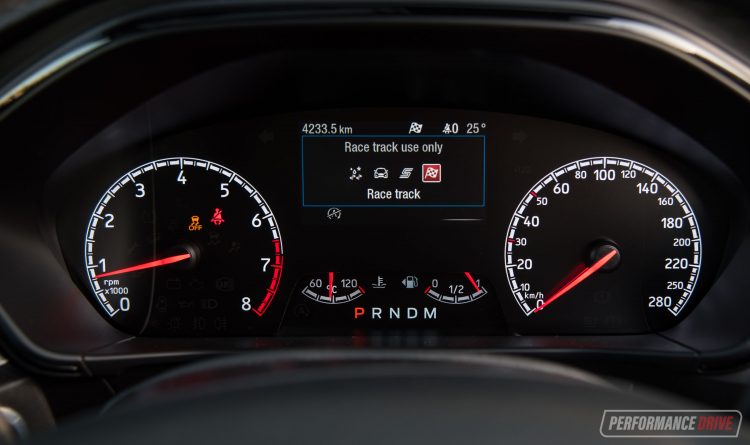
In the driver’s seat, the get-go feels very energetic and exciting. It doesn’t hesitate. In fact, this engine feels, to us, the most responsive out of all class rivals. And that’s in the normal driving mode. There’s also Sport and a Track mode to discover, which turn up engagements levels to 11. The Track mode in particular almost makes the engine seem like a naturally aspirated unit. It’s that responsive. Unfortunately, there is no customisable driving mode like in the Hyundai i30 N, for example.
There is loads and loads of torque, regardless of the mode, which means you don’t need to keep the revs as high as you think, or want to. The only trouble is that all that power and torque travels through the front wheels only, which results in lots of torque-steer and wheelspin. Especially with the manual transmission. Make sure not to accelerate too hard on a narrow road or a road with small bumps or you’ll feel like you’re navigating a battlefield.
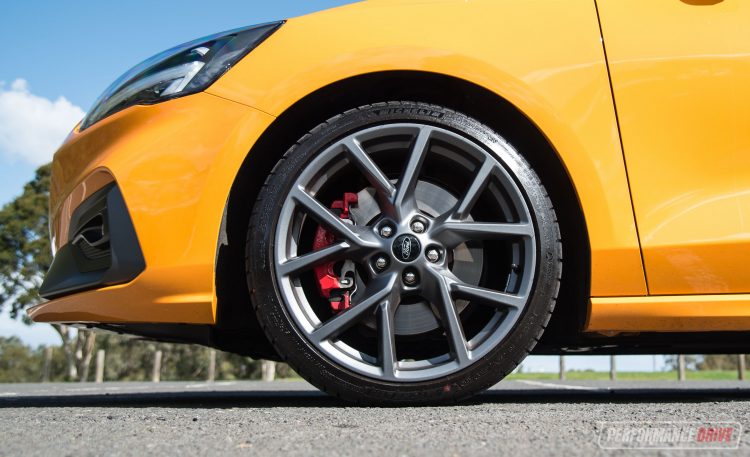
Nonetheless, it feels thoroughly entertaining to drive and it sounds great, too. You get angry crackles between gear shifts, especially in Track mode as mentioned, and the steering and handling provide a really connected feel. In that sense, you can have lots of fun kicking this hot hatch around bendy country roads. You get three-tube shocks with continuously controlled damping that senses road conditions every two milliseconds, as well as sticky Michelin Pilot Sport 4 S tyres, and an electronic limited-slip differential to help you through.
There is tonnes of grip around corners, and the suspension is tensed and ready for any impact. So much so that you inevitably feel even smaller bumps and divots in the road. However, we wouldn’t describe this as the firmest setup in this class. Far from it, actually. If you leave it in the normal mode, which still provides high levels of fun and sportiness, the suspension is fairly forgiving and compliant. For this style of vehicle anyway.
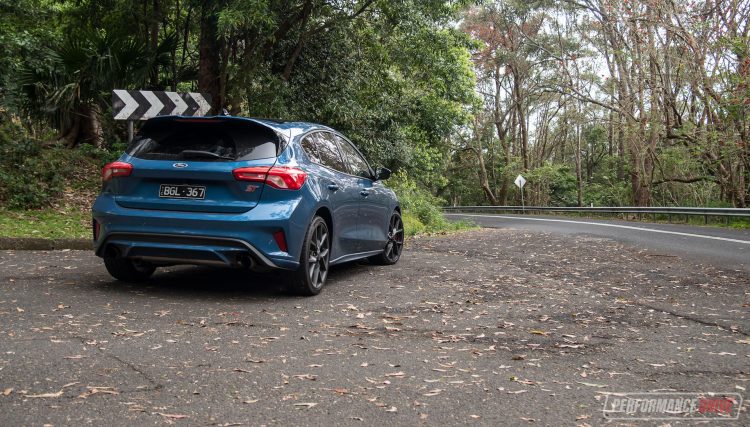
The seven-speed auto is refined and organised, and suits performance driving when the time calls. Our pick is the manual version though, with its rev-matching feature and more interactive drive experience. In saying that, the auto is the more refined option, perhaps ideally suited to regular city commuters who enjoy a spirited drive on the weekend. With the auto the Focus ST is civilised and well mannered in normal conditions, but then still provides almost the same level of thrill on the open road as the manual. Not to mention it is quicker.
Given the Focus ST is officially a hot hatch, fuel consumption may not be the highest of priorities. But this is not as bad as you might think, especially being a larger four-cylinder. Officially, it burns an average of 8.1L/100km in the manual, and our week average gave us the same result. The auto uses 8.6L/100km officially, and we averaged slightly more, at 8.9L/100km over a similar week of driving. A minimum of 95 RON fuel is needed in the ST, meanwhile, many hot hatches require 98 RON.
2020 Ford Focus ST – THE VIDEO
2020 Ford Focus ST – THE VERDICT
What we love most about the new Focus ST is that it is so well balanced. It’s not overly sharp or too hardcore in any particular area. Instead, it’s practical and civilised when you want it to be, yet it’ll let its hair down and party all weekend if that’s what you want as well. And it doesn’t feel upset in either atmosphere.
Sure, the auto is very tempting and it is actually quicker, it’s the manual that wins our heart. But we totally get why many will opt for the self-changer, especially when practicality and sheer versatility is a higher priority.
[column width=”47%” padding=”6%”]PROS:
– Ripper of an engine; punchy and accessible power throughout the rev range
– Really characterful handling means lots of fun to drive
– Overhauled interior is now modern and practical
– Excellent value and bang-for-buck
– Impressive standard tech
[/column] [column width=”47%” padding=”0″]CONS:
– Lots of torque steer, especially the manual
– No customisable driving mode
– Manual misses out on adaptive cruise control
– Auto seems quieter, no pops/crackles from exhaust[/column][end_columns]
As always, if you’re thinking about buying a new car don’t forget to click here to speak with our car buying specialists.
